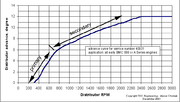
The minimum advance values are extracted from the 1980 edition of the Repair Operation Manual, as far as 2000 rpm at the crankshaft, and extrapolated to the limits set by the stop on the beak inside the centrifugal advance mechanism. The value for the knee and the reduced slope above that in the 41655's curve is estimated from a new set of springs in a good distributor, but may not be exact. The maximum advance values are also from the ROM up to 2000, and the estimates for the wear in the stop are mine. So, again, the upper limits may not be exact.
The limit on the advance for the early one, the 41402, came as a bit of a surprise. It's been suggested that the change to the next, 41589, was because of the loss of availability of 5 star leaded petrol at about the time the Sprint was launched. So I was expecting the 41402 to have a higher limit than the 41589, if a slightly lower rate of advance. But as can be seen, it's by far the lowest maximum value, and only the last, 41655, has a lower slope for advance at the lower end of the rpm range.
I'd certainly appreciate any views on what that means to performance and risks with lower octane fuel, e.g. 97 RON super-unleaded fuel.
I was also surprised at the 41402 being a bit different from the other two models, which, except for the stop value and spring rates, are the same. The method for holding the baseplate is using a sort of wedge-lock with a split in the plate with a screw in it; where the others use two screws into the body, like the 45D uses. I've seen this wedge lock before in a Lucas distributor, but it's not the 45D or the 25D. So I think I must have had one of these 41402's apart before and forgotten about it (there's a reason why my memory is so bad, but I've forgotten what it is).
Here are pictures of the baseplates of a 41402 and a 41589:


The baseplate mounting on the 41402 allows it to be fitted 90 degrees round, with the vacuum advance turned over, and so working the other way. I guess that's to allow it to be used where rotation is clockwise, instead of anticlockwise like the Sprint. It also makes the bolts that hold the distributor to the mounting plate much easier to get at from above.
Apart from the baseplate and advance limit value, there don't seem to be any obvious other differences to the mechanisms. So the later spring sets should fit, with a limited effect from such a small stop value. It should also be possible to swap the main shaft from a later one into the 41402 body, to give the same curves as either of the other two. I was considering doing that with one from a 41655, to get the higher stop with lower initial rate and much lower rate above about 3100 rpm. But seeing the set of curves, I wonder now if that's the right way to go.
Graham





